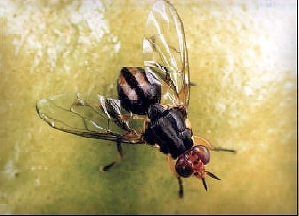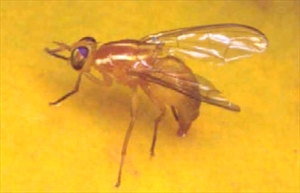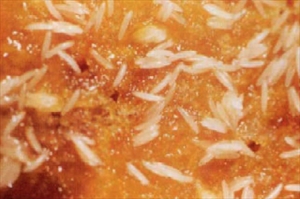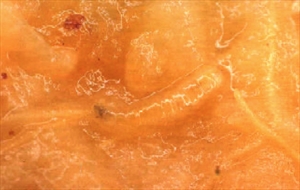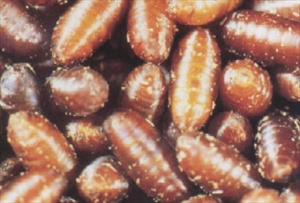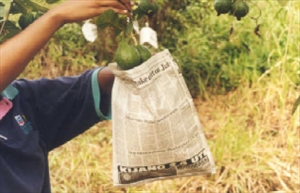- Bactrocera kirki - guava, mango, avocado; Bactrocera passiflorae - guava, citrus, mango, kavika; Bactrocera xanthodes - breadfruit, jackfruit, papaya; many more hosts, and fruit fly species occur.
- Note, Bactrocera kirki is present only on Rotuma.
- Females need protein before they can lay viable eggs.
- Cultural control: bag fruit with paper or leaves; collect fallen fruit and destroy; harvest early (banana and papaya); some non-hosts, e.g., chilli, pineapple.
- Chemical control: use a commercial protein bait spray, e.g. MPPIL, Royal Tongalure or Bactrogel.
Pacific Pests, Pathogens and Weeds - Online edition
Pacific Pests, Pathogens, Weeds & Pesticides
Fiji fruit flies (170)
There are seven fruit flies in Fiji: The species of economic importance are: (i) Bactrocera kirki (no common name), (ii) Bactrocera xanthodes (the Pacific fruit fly), (iii) Bactrocera passiflorae (Fijian fruit fly), (iv) Bactrocera distincta, and (v) Bactrocera species near passiflorae. Bactrocera gnetum and Bactrocera obscura are not of economic importance.
Bactrocera distincta, Bactrocera kirki, Bactrocera gnetum, Bactrocera obscura, Bactrocera passiflorae, Bactrocera species near passiflorae, and Bactrocera xanthodes. Bactrocera xanthodes is closely related to three other species: Bactrocera paraxanthodea in New Caledonia, and Bactrocera neoxanthodes in Vanuatu, and a species not yet described from Samoa.
AUTHOR Grahame Jackson
1Information from Swaine G (1971) Agricultural Zoology in Fiji. Her Majesty's Stationery Office. London; and (information and photos) Fruit flies in Fiji Islands (2000), SPC Pest Advisory Leaflet 28. (https://lrd.spc.int/pest-advisory-leaflet?start=15); and from Fruit fly control methods for Pacific island countries and territories (2001), SPC Pest Advisory Leaflet 40. (https://lrd.spc.int/pubs/cat_view/469-pest-advisory-leaflets).
Produced with support from the Australian Centre for International Agricultural Research under project PC/2010/090: Strengthening integrated crop management research in the Pacific Islands in support of sustainable intensification of high-value crop production, implemented by the University of Queensland and the Secretariat of the Pacific Community.
